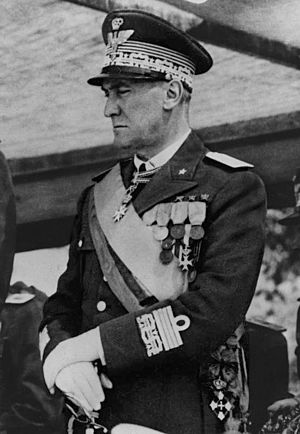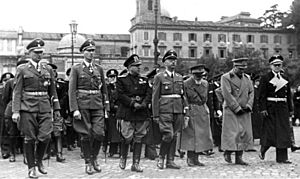Rodolfo Graziani facts for kids
Quick facts for kids
Rodolfo Graziani
|
|
|---|---|

Rodolfo Graziani in 1940
|
|
| Minister of National Defence of the Italian Social Republic |
|
| In office 23 September 1943 – 25 April 1945 |
|
| President | Benito Mussolini |
| Preceded by | Office created |
| Succeeded by | Office abolished |
| Governor-General of Italian East Africa | |
| In office 11 June 1936 – 21 December 1937 |
|
| Monarch | Victor Emmanuel III |
| Prime Minister | Benito Mussolini |
| Preceded by | Pietro Badoglio |
| Succeeded by | Amedeo, Duke of Aosta |
| Governor-General of Italian Libya | |
| In office 1 July 1940 – 25 March 1941 |
|
| Preceded by | Italo Balbo |
| Succeeded by | Italo Gariboldi |
| Governor of Italian Somaliland | |
| In office 6 March 1935 – 9 May 1936 |
|
| Preceded by | Maurizio Rava |
| Succeeded by | Angelo De Ruben |
| Vice-Governor of Italian Cyrenaica | |
| In office 17 March 1930 – 31 May 1934 |
|
| Preceded by | Domenico Siciliani |
| Succeeded by | Office abolished |
| Personal details | |
| Born | 11 August 1882 Filettino, Kingdom of Italy |
| Died | 11 January 1955 (aged 72) Rome, Italy |
| Resting place | Cemetery of Affile, Italy |
| Political party | National Fascist Party (1924–1943) Republican Fascist Party (1943–1945) Italian Social Movement (1946–1955) |
| Spouses |
Ines Chionetti
(m. 1913–1955) |
| Children | One daughter |
| Alma mater | Military Academy of Modena |
| Profession | Military officer |
| Military service | |
| Allegiance | |
| Branch/service | |
| Years of service | 1900–1945 |
| Rank | Marshal of Italy |
| Unit | Italian 10th Army |
| Battles/wars |
|
Rodolfo Graziani (born August 11, 1882 – died January 11, 1955) was an important Italian military officer. He was known for his military actions in Africa before and during World War II. Graziani was a strong supporter of Italian fascism and a key figure in the Italian army under Victor Emmanuel III.
He helped Italy expand its Italian colonial empire in the 1920s and 1930s. He first served in Libya and then in Ethiopia. Graziani became known for using very strict methods. These included setting up camps where many civilians died. He also took harsh actions against people resisting the Italian army. Because of his tough methods in Libya, he was called Il macellaio del Fezzan, meaning "the butcher of Fezzan".
In 1937, after an attempt to harm him in Addis Ababa, Graziani ordered a period of severe retaliation known as Yekatit 12. When Italy joined World War II, he led troops in Italian North Africa. However, he resigned after a British attack in 1940-1941 defeated his forces.
After the fall of the Fascist regime in Italy in 1943, Graziani was the only high-ranking general who stayed loyal to Benito Mussolini. He became the Minister of Defence for the Italian Social Republic. He led its army against the Allies until the war ended. Graziani was never tried by the United Nations War Crimes Commission. He was on a list of Italians who could be tried for war crimes. However, the Allies did not push for his trial. In 1948, an Italian court sentenced Graziani to 19 years in prison for working with the Nazis. He was released after only four months. In his later years, he became involved in politics and died in 1955.
Contents
Early Life and Military Start
Rodolfo Graziani was born in Filettino, Italy, on August 11, 1882. His father was a doctor. Rodolfo studied in a seminary and then at a high school in Rome. Because his family did not have much money, he could not go to a military academy. Instead, he decided to study law at university.
In 1900, Graziani joined the Royal Italian Army as a reserve officer while still at university. In 1906, he became a second lieutenant. His first assignment was in Italian Eritrea, where he learned Arabic and Tigrinya. In 1918, during World War I, Graziani became the youngest Colonnello (Colonel) in Italian history.
Campaigns in Africa
Actions in Libya
In 1930, the Italian government made Graziani the Vice-Governor of Cyrenaica. He also became the commander of Italian forces in Libya. He stayed in this role until 1934. During this time, he put down the Senussi rebellion. In this "pacification" effort, he built several concentration camps and labor camps. Thousands of Libyan prisoners died in these camps.
In 1935, Graziani was made Governor of Italian Somaliland.
Role in Ethiopia
During the Second Italo-Ethiopian War in 1935 and 1936, Graziani led the southern Italian forces. His army entered Ethiopia from Italian Somaliland. He commanded Italian troops in battles like Genale Doria and the Ogaden.
However, the main Italian attack came from Eritrea, led by General Emilio De Bono and later Pietro Badoglio. It was Badoglio who entered Addis Ababa first in May 1936. Graziani had wanted to reach Harar before Badoglio reached Addis Ababa, but he did not succeed. Still, on May 9, Graziani was promoted to the rank of Marshal of Italy for his role.
After the war, Graziani became the Viceroy of Italian East Africa. He was also the Governor-General of Shewa / Addis Ababa. On February 19, 1937, two Eritreans tried to harm him. In response, Graziani ordered a period of harsh actions across the country. This event is known by Ethiopians as Yekatit 12. Up to thirty thousand civilians in Addis Ababa were killed. Many others were executed or sent away from Ethiopia. Graziani became known as "the Butcher of Ethiopia."
World War II and Later Life
At the start of World War II, Graziani was the Commander-in-Chief of the Italian Army's General Staff. After Marshal Italo Balbo died in June 1940, Graziani took his place. He became the Governor General and Commander-in-Chief of Italian North Africa.
The Italian leader Benito Mussolini ordered Graziani to invade Egypt by August 8, 1940. Graziani was not sure his army was ready to defeat the British. He delayed the invasion as long as he could.
However, Graziani eventually followed orders. Four divisions of the Italian 10th Army invaded Egypt on September 9. The Italians made only small gains. They then set up fortified camps to defend their positions. In December 1940, the British attacked. They completely defeated the Italian 10th Army. On March 25, 1941, Graziani was replaced by General Italo Gariboldi. Graziani then remained mostly out of action for two years.
Graziani was the only Italian Marshal who stayed loyal to Mussolini after the fall of the Fascist regime in Italy. He joined Mussolini in northern Italy after Italy surrendered to the Allies. He was made Minister of Defense of the Italian Social Republic by Mussolini. He oversaw the mixed Italian and German forces. Graziani's forces defeated Allied troops in the "Battle of Garfagnana" in December 1944.
When Mussolini fled on April 25, 1945, Graziani was left as the leader of what remained of the Italian Social Republic. Mussolini was captured and executed a few days later. The next day, German forces in Italy surrendered. Graziani surrendered on May 1, 1945.
After World War II, Graziani was held by Allied forces. He was taken to Africa and stayed there until February 1946. Then, he was moved to a prison in Italy. He died of natural causes in Rome at age 72.
Books by Graziani
Graziani wrote several books, including:
- Ho difeso la Patria (una vita per l'Italia) (I Defended the Homeland (A Life for Italy))
- Africa settentrionale 1940–41 (North Africa 1940–41)
- Libia redenta (Libya Redeemed)
- Verso il Fezzan (Towards Fezzan)
- La riconquista del Fezzan (The Reconquest of Fezzan)
- Cirenaica pacificata (Cyrenaica Pacified)
- Pace romana in Libia (Roman Peace in Libya)
See Also
 In Spanish: Rodolfo Graziani para niños
In Spanish: Rodolfo Graziani para niños
- Frontier Wire (Libya)


